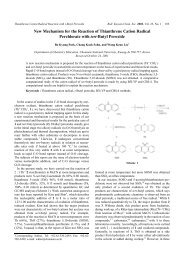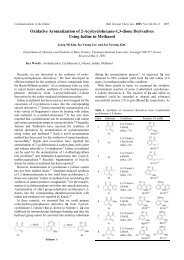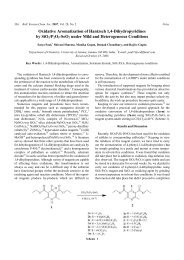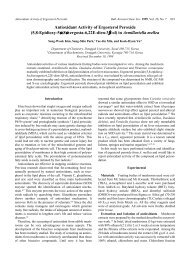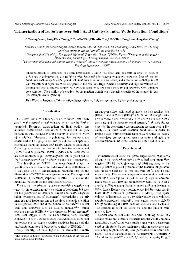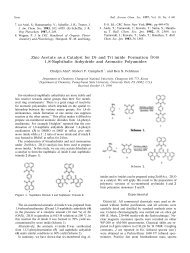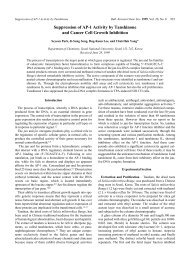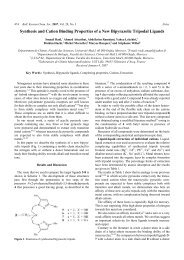Bromination of Activated Arenes by Oxone® and Sodium Bromide
Bromination of Activated Arenes by Oxone® and Sodium Bromide
Bromination of Activated Arenes by Oxone® and Sodium Bromide
You also want an ePaper? Increase the reach of your titles
YUMPU automatically turns print PDFs into web optimized ePapers that Google loves.
Notes Bull. Korean Chem. Soc. 2002, Vol. 23, No. 5 773<br />
<strong>Bromination</strong> <strong>of</strong> <strong>Activated</strong> <strong>Arenes</strong> <strong>by</strong> Oxone ® <strong>and</strong> <strong>Sodium</strong> <strong>Bromide</strong><br />
Kee-Jung Lee, * Hye Kyung Cho, <strong>and</strong> Choong-Eui Song *,†<br />
Department <strong>of</strong> Industrial Chemistry, Hanyang University, Seoul 133-791, Korea<br />
† Life Science Division, Korea Institute <strong>of</strong> Science <strong>and</strong> Technology, Seoul 130-650, Korea<br />
Received January 25, 2002<br />
Keywords : <strong>Bromination</strong>, <strong>Arenes</strong>, <strong>Sodium</strong> bromide, Oxone ® .<br />
Brominated arenes are versatile intermediates in the<br />
synthesis <strong>of</strong> a wide variety <strong>of</strong> biologically active compounds<br />
<strong>and</strong> other speciality chemical products. 1 Many <strong>of</strong> the available<br />
methods <strong>of</strong> direct bromination <strong>of</strong> aromatic systems 2 involve<br />
the use <strong>of</strong> Br2-Lewis acids, 3 NBS-H2SO4-CF3CO2H, 4 NBS-<br />
PTSA, 5 NBS-NaOH, 6 NBS-SiO2, 7 Br2-Al2O3, 8 Br2-Zeolite, 9<br />
NBS-Amberlyst, 10 NBS-HZSM-5, 11 Clayzib, 12 tert-BuOOH- or<br />
H2O2-HBr, 13 <strong>and</strong> HBr-DMSO. 14 Especially, bromination <strong>of</strong><br />
some arenes with potassium bromide as alternative brominating<br />
reagent in the presence <strong>of</strong> sodium tungstate or ammonium<br />
molybdate as catalyst using hydrogen peroxide or sodium<br />
perborate as an oxidant has been developed. 15 Also,<br />
regioselective monobromination <strong>of</strong> aromatic ethers can be<br />
accomplished with a combination <strong>of</strong> NaClO2, NaBr, <strong>and</strong><br />
Mn(acac)3 catalyst with the aid <strong>of</strong> montmorillonite K10 or<br />
silica gel. 16<br />
Recent reports have dealt with the use <strong>of</strong> a triple salt<br />
(2KHSO5·KHSO4·K2SO4), which is commercially available<br />
as Oxone ® , <strong>and</strong> aqueous halides was conducted as a convenient<br />
halogenating reagent to achieve oxidation <strong>of</strong> α,βenones,<br />
17 bromination <strong>of</strong> pyrimidines, 18 oxidation <strong>of</strong> alcohols, 19<br />
side chain halogenation <strong>of</strong> toluene, 20 <strong>and</strong> N-chlorination <strong>of</strong><br />
amides <strong>and</strong> carbamate. 21 In addition, we have shown that<br />
sodium bromide combined with Oxone ® serves as effective<br />
reagent <strong>of</strong> bromodecarboxylation <strong>of</strong> various cinnamic acids 22<br />
<strong>and</strong> arylpropiolic acids, 23 bromodecarbonylation <strong>and</strong> bromodecarboxylation<br />
<strong>of</strong> electron-rich aromatic aldehydes <strong>and</strong><br />
acids, 24 halogenation <strong>of</strong> aromatic methyl ketones, 25 <strong>and</strong><br />
oxidation <strong>of</strong> benzyl alcohols. 26<br />
In the course <strong>of</strong> our study to extend the scope <strong>of</strong> the<br />
Oxone ® /NaBr reagent in organic synthesis, we have found<br />
that this reagent facilitates bromination <strong>of</strong> moderately<br />
activated aromatic compounds successfully. 27 The substrates<br />
examined in our studies <strong>and</strong> the results <strong>of</strong> the bromination<br />
are summarized in Table 1. The bromo compounds were<br />
identified <strong>by</strong> their 1 H NMR <strong>and</strong> mass spectral data <strong>and</strong> <strong>by</strong><br />
comparison with literature data. Optimization <strong>of</strong> the reaction<br />
conditions revealed that simple stirring a solution <strong>of</strong> arene (1<br />
equivalent), Oxone ® (1 equivalent) <strong>and</strong> sodium bromide (1<br />
equivalent) in a 1:1 mixture <strong>of</strong> CH3CN/H2O at room temperature<br />
effected the formation <strong>of</strong> bromoarene. It is noteworthy that<br />
bromination <strong>of</strong> anisole takes place regioselectively at the 4position,<br />
whereas in the case <strong>of</strong> acetanilide dibromination<br />
occurs at the 2,4-position independent <strong>of</strong> the stoichiometry<br />
* Corresponding author. E-mail: leekj@hanyang.ac.kr<br />
<strong>of</strong> the bromide employed (entries 1-2), <strong>and</strong> in the case <strong>of</strong><br />
naphthalene or 2-methoxynaphthalene, bromination occurs<br />
at the 1-position (entries 3-4). Disubstituted substrates furnished<br />
preferentially the monobrominated products (entries 5-8),<br />
however, 2-aminoacetophenone <strong>and</strong> 2-nitrophenol produced<br />
the corresponding dibromo compounds as sole products<br />
(entries 9-10) independent <strong>of</strong> the stoichiometry <strong>of</strong> the<br />
bromide employed. In the case <strong>of</strong> benzamide the expected<br />
N-bromobenzamide was obtained exclusively. 21 Other<br />
unactivated aromatic compounds such as benzonitrile <strong>and</strong><br />
methyl benzoate did not react. The reaction is carried out <strong>by</strong><br />
the species produced as a result <strong>of</strong> the peroxymonosulfateoxidaiton<br />
<strong>of</strong> the bromide anion. 28<br />
Table 1. <strong>Bromination</strong> <strong>of</strong> <strong>Arenes</strong> <strong>by</strong> Oxone ® <strong>and</strong> NaBr<br />
Entry Substrate Product No. oxone:<br />
NaBr<br />
a Yields in isolated products, b No reaction.<br />
Time<br />
(h)<br />
Yield<br />
(%) a
774 Bull. Korean Chem. Soc. 2002, Vol. 23, No. 5 Notes<br />
The method described in this note is a simple nuclear<br />
bromination <strong>of</strong> activated arenes <strong>by</strong> Oxone ® /NaBr in aqueous<br />
acetonitrile under the mild conditions. In many cases simple<br />
extraction (Et2O) <strong>of</strong> reaction mixture <strong>and</strong> evaporation <strong>of</strong> the<br />
solvent provide the products in high yields. Since Oxone ®<br />
<strong>and</strong> sodium bromide are cheap, nontoxic, stable, <strong>and</strong> easy to<br />
h<strong>and</strong>le, the present method should be useful in synthetic<br />
organic chemistry.<br />
Experimental Section<br />
All chemicals used were purchased from commercial<br />
sources <strong>and</strong> were used as received unless otherwise stated.<br />
Melting points were taken using an Electrothermal melting<br />
point apparatus <strong>and</strong> are uncorrected. 1 H NMR spectra were<br />
recorded on a Gemini 300 spectrometer. Mass spectra were<br />
obtained using a ThermoQuest Polaris Q mass spectrometer<br />
operating at 70 eV.<br />
General Procedure for the Preparation <strong>of</strong> Bromoarenes.<br />
<strong>Sodium</strong> bromide (5 mmol, 0.51 g) was added to a stirred<br />
solution <strong>of</strong> arenes (5 mmol) in 30 mL <strong>of</strong> CH3CN-H2O (2 : 1<br />
v/v), <strong>and</strong> then followed <strong>by</strong> the dropwise addition <strong>of</strong> Oxone ®<br />
(5 mmol, 3.07 g) in 10 mL <strong>of</strong> H2O. Reactions were continuously<br />
monitored <strong>by</strong> thin-layer chromatography <strong>and</strong> stirred at r.t.<br />
for generally 0.5 h to 24 h. The reaction mixture was<br />
quenched with aqueous sodium thiosulfate, <strong>and</strong> extracted<br />
with Et2O (3 × 30 mL). The combined organic layers were<br />
washed with water, dried over anhydrous MgSO4, filtered,<br />
<strong>and</strong> concentrated in vacuo. The residue was crystallized with<br />
petroleum ether or chromatographed on a silica gel column<br />
<strong>and</strong> eluted with hexane-ethyl acetate 15 : 1 to give the<br />
products.<br />
The spectral <strong>and</strong> analytical data <strong>of</strong> products are as follows:<br />
1: Liquid (Lit. 29 215°); 1 H NMR (CDCl3) δ 3.78 (s, 3H),<br />
6.78 (d, 2H, J = 9.16 Hz), 7.34 (d, 2H, J = 9.16 Hz); MS m/z<br />
(%) 188 (M+2, 76), 186 (M + , 100).<br />
2: mp 144-145° (Lit. 30 144.7°); 1 H NMR (CDCl3) δ 2.24<br />
(s, 3H), 7.43 (dd, 1H, J = 8.85 <strong>and</strong> 2.14 Hz), 7.56 (bs, 1H),<br />
7.68 (d, 1H, J = 2.14 Hz), 8.26 (d, 1H, J = 8.85 Hz); MS m/z<br />
(%) 295 (M+4, 25), 293 (M+2, 48), 291 (M + , 22), 253 (52),<br />
251 (100), 249 (50), 214 (69), 212 (69).<br />
3: Liquid (Lit. 29 139°/16 Torr); 1 H NMR (CDCl3) δ 7.23-<br />
7.83 (m, 6H), 8.20-8.23 (m, 1H); MS m/z (%) 208 (M+2,<br />
100), 206 (M + , 95), 127 (25).<br />
4: mp 83-84° (Lit. 29 85°); 1 H NMR (CDCl3) δ 4.04 (s, 3H),<br />
7.27-7.84 (m, 5H), 8.22 (d, 1H, J = 8.55 Hz); MS m/z (%)<br />
238 (M+2, 100), 236 (M + , 98), 195 (53), 193 (56), 114 (17).<br />
5: mp 108-110° (Lit. 31 109-111°); 1 H NMR (CDCl3) δ<br />
4.63 (s, 2H), 6.74 (d, 1H, J = 8.55 Hz), 7.38 (dd, 1H, J =<br />
8.55 <strong>and</strong> 1.83 Hz), 7.70 (d, 1H, J = 1.83 Hz); MS m/z (%)<br />
198 (M+2, 97), 196 (M + , 100), 117 (52), 90 (28).<br />
6: mp 64-66° (Lit. 32 65-67°); 1 H NMR (CDCl3) δ 4.07 (s,<br />
2H), 6.69 (d, 1H, J = 8.55 Hz), 7.07 (dd, 1H, J = 8.55 <strong>and</strong><br />
2.44 Hz), 7.40 (d, 1H, J = 2.44 Hz); MS m/z (%) 207 (M+2,<br />
100), 205 (M + , 71), 126 (8).<br />
7: mp 154-155° (Lit. 33 155-156°); 1 H NMR (CDCl3) δ<br />
2.50 (s, 3H), 4.61 (bs, 2H), 6.75 (d, 1H, J = 7.24 Hz), 7.74<br />
(dd, 1H, J = 7.24 <strong>and</strong> 1.83 Hz), 8.06 (d, 1H, J = 1.83 Hz);<br />
MS m/z (%) 215 (M+2, 92), 213 (M + , 90), 200 (100), 198<br />
(90).<br />
8: mp 70-71° (Lit. 32 74°); 1 H NMR (CDCl3) δ 3.87 (s, 3H),<br />
5.75 (s, 2H), 6.56 (d, 1H, J = 8.85 Hz), 7.33 (dd, 1H, J =<br />
8.85 <strong>and</strong> 2.44 Hz), 7.97 (d, 1H, J = 2.44 Hz); MS m/z (%)<br />
231 (M+2, 96), 229 (M + , 100), 199 (59), 197 (62).<br />
9: mp 119-121° (Lit. 34 123-124°); 1 H NMR (CDCl3) δ<br />
2.59 (s, 3H), 6.82 (bs, 2H), 7.69 (d, 1H, J = 2.44 Hz), 7.81<br />
(d, 1H, J = 2.44 Hz); MS m/z (%) 295 (M+4, 51), 293 (M+2,<br />
100), 291 (M + , 52), 280 (36), 278 (76), 276 (36), 250 (12).<br />
10: mp 116-117° (Lit. 29 118°); 1 H NMR (CDCl3) δ 7.99 (d,<br />
1H, J = 2.44 Hz), 8.25 (d, 1H, J = 2.44 Hz), 11.06 (s, 1H);<br />
MS m/z (%) 299 (M+4, 51), 297 (M+2, 100), 295 (M + , 53),<br />
241 (24), 239 (50), 237 (22).<br />
11: mp 127-129° (Lit. 32 129-131°); 1 H NMR (CDCl3) δ<br />
6.79 (s, 1H), 7.39-7.56 (m, 3H), 7.77-7.81 (m, 2H); MS m/z<br />
(%) 121 (56), 105 (100), 77 (53), no M + .<br />
References<br />
1. Christophersen, C. Acta Chem. Sc<strong>and</strong>. 1985, 39B, 515.<br />
2. (a) Smith, M. B.; March, J. In Marchs Advanced Organic Chemistry:<br />
Reactions, Mechanisms <strong>and</strong> Structure, 5th ed.; John Wiley &<br />
Sons: New York, 2001; pp 704-707 <strong>and</strong> references cited therein.<br />
(b) Larock, R. C. In Comprehensive Organic Transformations;<br />
VCH: New York, 1989; pp 315-318.<br />
3. Schmid, H. Helv. Chim. Acta 1946, 29, 1144.<br />
4. Duan, J.; Zhang, L. H.; Dolbier, Jr. W. R. Synlett 1999, 1245.<br />
5. Bovonsombat, P.; McNelis, E. Synthesis 1993, 237.<br />
6. Auerbach, J.; Weissman, S. A.; Blacklock, T. J.; Angeles, M. R.;<br />
Hoogsteen, K. Tetrahedron Lett. 1993, 34, 931.<br />
7. Konishi, H.; Aritomi, K.; Okano, T.; Kiji, J. Bull. Chem. Soc. Jpn.<br />
1989, 62, 591.<br />
8. Ranu, B. C.; Sarkar, D. C.; Chakraborty, R. Synth. Commun. 1992,<br />
22, 1095.<br />
9. (a) Vega, F.; Sasson, Y.; Huddersman, K. Zeolites 1993, 13, 341.<br />
(b) Smith, K.; Bahzad, D. J. Chem. Soc. Chem. Commun. 1996,<br />
467.<br />
10. Goldberg, Y.; Alper, H. J. Mol. Cat. 1994, 88, 377.<br />
11. Paul, V.; Sudalai, A.; Daniel, T.; Srinivasan, K. V. Tetrahedron<br />
Lett. 1994, 35, 7055.<br />
12. Clark, J. H.; Ross, J. C.; Macquarrie, D. J.; Barlow, S. J.; Bastock,<br />
T. W. J. Chem. Soc. Chem. Commun. 1997, 1203.<br />
13. Barhate, N. B.; Gajare, A. S.; Wakharkar, R. D.; Bedekar, A. V.<br />
Tetrahedron Lett. 1998, 39, 6349.<br />
14. (a) Majetich, G.; Hicks, R.; Reister, S. J. Org. Chem. 1997, 62,<br />
4321. (b) Srivastava, S. K.; Chauhan, P. M. S.; Bhaduri, A. J.<br />
Chem. Soc. Chem. Commun. 1996, 2679.<br />
15. (a) Choudary, B. M.; Sudha, Y.; Reddy, P. N. Synlett 1994, 450.<br />
(b) Hanson, J. R.; Opakunle, A.; Petit, P. J. Chem. Research (s),<br />
1995, 457. (c) B<strong>and</strong>gar, B. P.; Nigal, M. N. J. Synth. Commun.<br />
1998, 28, 3225.<br />
16. (a) Hirano, M.; Yakabe, S.; Monobe, H.; Morimoto, T. Synth.<br />
Commun. 1998, 28, 669. (b) Hirano, M.; Monobe, H.; Yakabe, S.;<br />
Morimoto, T. Synth. Commun. 1998, 28, 1463.<br />
17. Dieter, R. K.; Nice, L. E.; Velu, S. E. Tetrahedron Lett. 1996, 37,<br />
2377.<br />
18. Ross, S. A.; Burrows, C. J. Tetrahedron Lett. 1997, 38, 2805.<br />
19. Bolm, C.; Magnus, A. S.; Hildebr<strong>and</strong>, J. P. Org. Lett. 2000, 2,<br />
1173.<br />
20. Kennedy, R. J.; Stock, A. M. J. Org. Chem. 1960, 25, 1901.<br />
21. Curini, M.; Epifano, F.; Marcotullio, M. C.; Rosati, O.; Tsadjout,<br />
A. Synlett 2000, 813.
Notes Bull. Korean Chem. Soc. 2002, Vol. 23, No. 5 775<br />
22. You, H.-W.; Lee, K.-J. Synlett 2001, 105.<br />
23. Lee, K.-J.; Lim, K. W.; Chi, D. Y. Bull. Korean Chem. Soc. 2001,<br />
22, 549.<br />
24. Koo, B.-S.; Kim, E.-H.; Lee, K.-J. Synth. Commun. 2002, 32, in<br />
press.<br />
25. Kim, E.-H.; Koo, B.-S.; Song, C.-E.; Lee, K.-J. Synth. Commun.<br />
2001, 31, 3627.<br />
26. Koo, B.-S.; Lee, C. K.; Lee, K.-J. Synth. Commun. 2002, 32, in<br />
press.<br />
27. (a) Presented at “The 88th Annual Meeting <strong>of</strong> The Korean Chemical<br />
Society” October 19, 2001. Book <strong>of</strong> Abstracts, p 352. (b)<br />
When our study was finished, the same method was reported, see<br />
Tamhankar, B. V.; Desai, U. V.; Mane, R. B.; Wadgaonkar, P. P.;<br />
Bedekar, A. V. Synth. Commum. 2001, 31, 2021.<br />
28. Montgomery, R. E. J. Am. Chem. Soc. 1974, 96, 7820.<br />
29. CRC H<strong>and</strong>book <strong>of</strong> Chemistry <strong>and</strong> Physics, 68th ed.; Weast, R. C.;<br />
Astle, M. J.; Beyer, W. H., Eds.; CRC Press, Inc.: Florida, 1987.<br />
30. Owen, G. J. Chem. Soc. 1923, 123, 3392.<br />
31. Crundwell, E. J. Chem. Soc. 1956, 368.<br />
32. Dictionary <strong>of</strong> Organic Compounds, 6th ed.; Cadogan, J. I. G.;<br />
Ley, S. V.; Pattenden, G.; Raphael, R. A.; Rees, C. W., Eds.; Chapman<br />
& Hall: London, 1996.<br />
33. Raiford, C. L.; Davis, H. L. J. Am. Chem. Soc. 1928, 50, 156.<br />
34. Leonard, N. J.; Boyd, Jr. S. N. J. Org. Chem. 1946, 11, 405.



![One-Pot Synthesis of Naphth[2',3':4,5]imidazo[1,2-a]pyridine-6,11](https://img.yumpu.com/21946252/1/184x260/one-pot-synthesis-of-naphth2345imidazo12-apyridine-611.jpg?quality=85)
